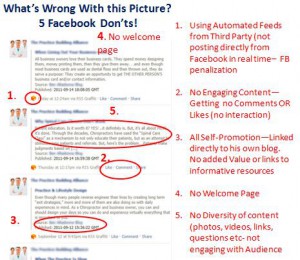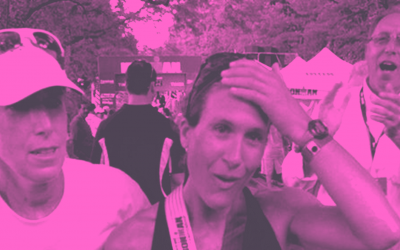by Laura | Dec 16, 2010 | Facebook, Marketing, Social Media Tips
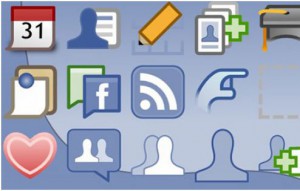 I have been asked this question a lot lately from business owners in my local community—“What is the difference between Facebook personal profile, groups, and fan pages?” It’s a great question and very important that you understand the differences because they are not the same thing and therefore should be used for very different purposes.
I have been asked this question a lot lately from business owners in my local community—“What is the difference between Facebook personal profile, groups, and fan pages?” It’s a great question and very important that you understand the differences because they are not the same thing and therefore should be used for very different purposes.
One of the biggest mistakes that I see people making is that they are using personal account for business purposes. Not only is it not best practices, but Facebook does not allow business promotions on personal accounts. Recently, I noticed a friend of mine who manages a local retail store was using his own personal profile account to promote featured items and discounts being offered at his store. He had all good intentions, but the right approach would have been to set up a business (fan) page for reasons that I will explain later.
I offered to help set up Facebook business page, but he said he had someone in his store taking care of that—and I thought GREAT!! But, the next day I noticed something else. Rather than getting an invite to join new fan page (business page) for that store, I got a friend request! Unfortunately, the person who set up the new “profile account” (not a business page) for the retail store did not understand the key differences and advantages for having a designated business page for that store– and unless this is done, there will be major missed business opportunities.
In this post, I will outline the key differences between personal profile, groups, and pages and the advantages for each and why it is essential to have a business page to grow your business, brand, or image.
Facebook Personal Profile:
Facebook personal profiles are meant to represent single individuals. The reason why most people use their personal page is to connect and interact with friends and family. However, there are two schools of thought for using your personal account. Some people use this account only for close circle of friends and family members while others will leverage Facebook to build a larger professional network and to develop new relationships outside of family and close friends.
Personally, I believe it is always better to grow your network so I am of the school of thought to use Facebook for both building personal and professional relationships. However, personal profiles are not meant to promote your business—that should be reserved for your business page. For example, my personal account and my updates are mainly about personal interests and hobbies and the content on my business page contains useful information relating to social media.
Differences with Facebook Personal Profile:
- Personalized home page – the redesigned personal profile page creates a more social experience and makes it easier for people to see a snapshot you. The new features display a summary of personal information, relationship, recently tagged photos, and top interests showcased as images.
- Closed network made up of reciprocal relationship- must mutually agree to be “friends”
- Tight knit invitational community– personalized friend request or invite to become friends
- More activity from friends News Feed than from Fan Page news feeds- everyone looks at their personal home page/ news feeds
- Limit of 5,000 friends
- Content is not indexed by Google/ search engines
- Cannot be used for business purposes (no selling or promoting product/services)—this is against Facebook’s terms of service
- Only allowed 1 profile page
Facebook Business (Fan) Page
Unlike the personal profile page, Facebook pages are for businesses, organizations, and brands to share information publicly with people who choose to connect with them (“Like” their page). Similar to profiles, pages can be enhanced with applications that engage with their audiences, and capture new audiences virally through friend recommendations, News Feeds, events, and more.
Over the past several months Facebook rolled out tools and enhanced social features that allowed web users to experience a personalized version of the internet. Today more than a million websites have now integrated with the Facebook platform and it continues to grow at a rate of more than 10,000 websites per day.
Essentially Facebook has wrapped an entire social layer over the internet–thereby creating unprecedented marketing potential and business opportunities. But, for the purpose of this post, I will stick to outlining the main differences between profile, business page, and groups:
Differences with the Facebook Business Page:
- Open network—anyone can join or “like” your fan page.
- SEO (Search Engine Optimization) — indexed with search engines so can increase rankings
- Unlimited number of people can like your page—(vs. 5,000 friends)
- Ability to run hyper targeted Facebook Ad campaigns
- Create custom Facebook “welcome” Page— make a memorable first impression for your brand/ business which helps to increase your fan base
- Create sophisticated marketing promotions such as running sweepstakes, contests, or offering fans only special discounts, coupons, and other exclusive privileges using third party applications. Two great fan page examples: 1-800-flowers and Mercedes-Benz
- Can create unlimited number of business pages (to represent multiple industries or niches)
- Can track metrics on fan pages and analyze Facebook Insights/ viewer data
- Ability to do direct e-commerce and build a storefront. Two Facebook page examples to check out: JCPenny and Threadless (T-shirt Company)
- Build Email Opt-in list directly from page
- Market Research—Consider providing fans with exclusive content only fans can see and ask for their feedback. Use data to refine your product or service
- Customer service: great example- AT&T
Facebook Groups
With all the recent changes and continuously evolving features, it’s no surprise that Facebook has released a new version of Facebook groups. In fact, the only main thing in common with the old version is virtually the name itself.
The new Facebook Groups allows members to selectively share information with a smaller subset of people with whom you interact on a more regular basis, such as co-workers, family, friends, or classmates – the new design makes it easier for users to connect with other members.
The main difference between groups and pages is that groups are optimized for small subsets of people while Facebook pages are better suited for larger audiences and public affiliations. There are three group types: open, closed or secret. Groups are closed by default, but can be changed to group preference. Groups that are designated as secret are not unsearchable in the search feature of Facebook
Differences with Groups (and new features)
- Group Chat: Allows members to participate in back and forth conversations real-time with the group at the same time
- Docs: this is a shared notepad which allows members to collectively, write and edit notes with the group
- Mailing list-style notifications: Allows members of groups can keep up to date with email notifications about any posts in the group. In my opinion, I think this is a great new time saving feature if you just want to send the group a quick update – such as an event invite for example. I belong to two mastermind groups, one is secret and the other is closed. So far, I find the new Facebook groups to be very useful and much easier to communicate and share information with other members.
- Group Control: An important new feature is that the group is controlled by the entirety of its members. However, one feature to be aware of with the new groups is that the creator can appoint people to automatically become members of the group without their prior permission. I would recommend that you ask people first before assigning them to your group in case they are not interested in joining.
So you can see there are key differences among the Facebook profile, business page, and groups. Each has its own purpose and benefits. The way I look at it is this: Use your personal account to connect with your friends and to build new relationships strategically with people in your niche and who are your target audience. Discover mutual interests and commonalities to strengthen your connection.
Use your business page to engage with your fans, share valuable content—offer important information, tips, useful articles, and anything relevant and newsworthy for your target market. Take advantage of the numerous tools to market your business and grow your fan base.
Use groups to communicate with a smaller subset of people. The new groups feature makes it much easier to connect and share information with other members. For example, I’m a member of a social media mastermind group with other social media experts. We use the groups to mastermind together; ask questions; share tips, ideas & latest news; and to help and support each other.
If you found this useful, please share with others who could also benefit. If I missed anything or you have things to add, please share your comments below!
To your Success,
Laura DeMeo
by Laura | Nov 10, 2010 | Facebook, Marketing
 I am so excited because there is a celebrity in the making… and he doesn’t even know it yet! This guy is one of the most genuine, passionate, knowledgeable, down to earth… and just a cool person who has so much to offer! His name is Drew Neiman and he is a wine maker in Napa Valley. Just like a gifted artist can create masterpieces with nuances of complexity and meaning, so can Drew with his exceptional wines.
I am so excited because there is a celebrity in the making… and he doesn’t even know it yet! This guy is one of the most genuine, passionate, knowledgeable, down to earth… and just a cool person who has so much to offer! His name is Drew Neiman and he is a wine maker in Napa Valley. Just like a gifted artist can create masterpieces with nuances of complexity and meaning, so can Drew with his exceptional wines.
I met Drew Neiman recently on our wine trip to Napa Valley. After tasting his wines, I was surprised that I had never heard of him before. This is a shame because he makes such darn good wines and the rest of the world should know about it! Though he has an excellent reputation and is well known in his community (and some of their core networks among wine people), he really has not yet built a big name for himself outside that circle.
The purpose for writing this post is to share 7 ways Drew can go from being largely unknown to becoming a rock star in the food and wine industry & among the wine enthusiasts in a very short period of time using Facebook! The best thing is so can YOU in your niche market! By following exactly what I am about to share with you, you too can become an authority, celebrity-like figure in your industry and build a powerful profitable business.
But before I get into the specifics, I want to first provide the context for writing this post and give you a brief background of my recent trip to wine country. Then we’ll dive into the details. Sound good? If you want to jump ahead to get the 7 Facebook steps now, scroll down.
Napa Valley
I was inspired to write this article from my recent trip to Napa Valley and Oregon with wine aficionado Jon Brodsky. It was a fantastic trip that involved visits to wineries in Napa, runs and hikes, and a drive up the coast of Oregon with many cool stops along the way including Sand Dunes, Sea Lion caves, Cannon Beach, and Willamette valley (quest to find great Pinot Noirs), and finally stopping in Portland where we were supposed to run a 50K ultra run. Jon wrote an excellent blog post describing details of trip and a thorough wine review of each of the tastings in Napa Valley and Willamette valley. Click here read this very informative wine review— especially if you ever plan on visiting Napa or Willamette.
An Unforgettable Experience
This trip to Napa/ Oregon was an exceptional experience to say the least—thanks to our friends Norm and Mariam who connected us with friends who were well connected in Napa and had arranged for private tastings and tours with very special people! This was a 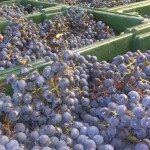 very unique experience because we had the opportunity to meet and spend time with the actual wine makers, farmers, and vineyard owners themselves— as a result I gained new insight and learned so much more about the wine making process – especially during this prime harvest time.
very unique experience because we had the opportunity to meet and spend time with the actual wine makers, farmers, and vineyard owners themselves— as a result I gained new insight and learned so much more about the wine making process – especially during this prime harvest time.
Napa and Social Media
Not only was this a very educational trip about exploring some of the best wines in Napa and pinot’s in Oregon, but as a social media marketing strategist I was also very interested from the marketing perspective. Having been to Napa at least 7 times over the past several years, I noticed this time around that many of the wineries are now using social media to market their businesses. Some are successful, most are not– the reality is that many businesses are not using social media…the right way. The good news is that once you understand core concepts and strategies, then it becomes a powerful game changer for your business
It is a super competitive marketplace today, especially in the wine industry—and businesses must continuously stand out and differentiate themselves from their competitors (in a more beneficial way) in order to sustain long term success. Just look at Napa Valley and Willamette Valley alone (the two main areas we visited) – there are hundreds of vineyards all within close proximity.
We must have visited 25 vineyards and about 3-5 really stood out (Herb Lamb, Drew Neiman, Kelly Flemming, possibly because they were private tastings and we got to develop relationships with the owners / wine makers themselves or in the case of Duckhorn and Peju’s general tastings, we had awesome experiences!)
So how does a vineyard stand out and attract their buyers with so many wines to choose from? Obviously to a wine aficionado, they are already going to have a preference and a loyalty to a certain brand. But to the average wine drinker, how to you win them over?!
It is all in the marketing — whether it is word of mouth, newsletters, print advertisements, and of course social media marketing. Obviously the product needs to be good or all the marketing in the world won’t help!
Throughout the trip, I was closely observing every single experience I had with each winery visit (and restaurants/hotels). From a social media marketing angle, I would play a game and think to myself “If I were a wine maker or estate owner what I would do to build a large following and attract lots of new customers! The possibilities are endless… even if wine production is limited!
Now back to Drew Neiman. I was particularly excited about the explosive potential with Neiman— here’s why: Drew was a fairly young guy who was clearly an expert wine maker and he had passion that was contagious! I don’t care what business you are in—if you are that passionate about what you do, you will attract the masses who share your passion. Now combine that with the power of social media. Having a strong presence on social networking giants like Facebook, Twitter, LinkedIn has literally transformed businesses.
The Rising Star…
In Drew’s case, I noticed that he has virtually zero social media presence— already poised for growth! In the next section, I am going to expose how this rising star can quickly become “famous” in the wine industry by building a powerful brand and huge community using social media. For purpose of this post, I am going to focus on Facebook strategies and will cover a Twitter and blog approach in second post of this series.
Because of Facebook’s sheer size of 550 million users (and exponentially getting bigger), it’s viral nature, and the ability to attract a massive following of targeted people including friends, influencers, prospects and customers—Facebook is no doubt where Drew needs to be!
I just want to make a quick point; even if you have no product yet or in Drew’s situation where he has limited production of wine to sell, he should absolutely still create a fan page for his business and work towards building his followership and strengthening his brand.
This is very important because once you have built a loyal audience who gets to know you, like you and trust you they will also buy from you. So for example, if and when Drew runs out of his supply, why not create a website and sell all kinds of wine accessories—he’ll already have a targeted audience that loves him! Note, the purpose for using Facebook and other social sites is to build community and relationships—there is no direct selling. You can occasionally send people to your website or some other place where services and products can be purchased.
So without further ado, let’s dive into 7 essential steps on Facebook that if implemented could catapult Drew from small business owner to celebrity-like status and authority within the wine industry—all while building a powerful brand and profitable business!
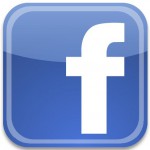 Facebook: 7 Steps To Success!
Facebook: 7 Steps To Success!
1. Set Up a Facebook Personal Profile
Upload a Picture – Drew has set up an account, but I don’t think there is any activity. The first thing I recommend is that he uploads a photo of himself. This will make a good first impression and people would be more like to connect with a real person they can see.
Fill Out Profile Information— Fill out basic information including bio. , “about me” section, work & education, Likes & Interests, and contact information. The reason for doing this is that when you are connecting with friends on Facebook and building a rapport, people want to learn more about who you are and if there are any mutual interests that will help develop the relationship
Add Targeted Friends— Start adding friends in your niche market. For example, find targeted friends on fan pages and groups that are related to the food and wine industry). Also find friends of friends who also share common interests. (See below for detail how to search and add target friends)
2. Facebook Business Page (Fan Page)
Custom Designed Welcome Page– Once you set up your basic Facebook page (you can get step by step instructions from my Facebook training by entering name/ email in on the right side), It is very Important to have a nicely designed welcome page, also known as landing page. Set the default settings so that people automatically Land on your welcome page. Welcome pages are peoples first impressions so do not skimp on it. The important thing you want your visitors to do is join your fan page so that your content then get’s shown in their newsfeeds which is key for spreading messages through larger networks!
For Best Results, a Welcome Page Should Include These FOUR Elements:
Clear Call to action to “Like” Page—Could say something like: “Click the Like button (with arrow pointing to Like) and connect with Drew Neiman
Video Message– Create a 90 second video introducing yourself and give a reason why people should join your fan page (for ex. Tips on food pairing, education about wine, etc). Video will be especially important for Drew because he such a likeable guy and is so incredibly passionate about wine. By creating a video message, his passion and genuineness will shine through and he will instantly connect with other wine lovers — and build trust and rapport with people in his target market
Written Message— On the welcome page, Drew should also include written message describing who Drew Neiman is, what he does, and the benefit why people would want to join Fan page.
Email Opt-In form– Have a way for people to enter email and subscribe to a monthly newsletter (or blog post). Every top marketer knows that your email list is your biggest asset. Drew should have an email contact form so he can start building his list, developing relationships with his subscribers by sharing his latest updates, news & tips about wine etc.
Next once you have a fan page, you will need to build your community. Here are ways Drew can quickly start building his followership on his Facebook Page:
Add Targeted Friends in niche market—wine lovers, restaurant owners, sommeliers, chefs, etc).
Facebook Search Feature – Use search feature to find fan pages and groups related to wine industry. Start adding targeted friends in niche market who are members of these groups or fan pages (relating to food & wine). For faster success, it is key to leverage large fan pages and groups to connect with target market and to widen your audience
Just from a quick search, here are fan pages and groups that I would start with: (there are tons of other fan pages!)
http://www.facebook.com/winesearcher (over 85,000 fans)
http://www.facebook.com//winelibrarytv (over 35,000 fans)
http://www.facebook.com/pages/Red-Wine/8536905548 (over 161,000)
For faster results, Drew should contact the Admin. of these fan pages and group and ask them to share a message to their group sending them to his new fan page. Also be sure to use your status updates to invite friends and inform them of new fan page.
3. Share Good Content and Be Active— it is not enough to just have a large following. Businesses are more successful on Facebook when they have very interactive fan page. The better you post good content on a consistent basis, the more likely you will have a lively community that participates and comments on your status updates and be regularly seen in the newsfeeds.
Anything that is noteworthy will be shared and will spread like wildfire. If your content is not engaging then you will virtually be invisible in the Newsfeeds. Also be sure to comment of friends updates as well.
4. Photos and Videos — Tests have been done to determine types of content that is most engaging and are “weighted” more in terms of rising to the top newsfeeds. Asking questions, sharing photos and Videos are among the top ways to drive those comments and likes on a fan page.
Back to Drew Neiman—Fortunately, his business in the wine industry is perfect for sharing videos and photos! Who doesn’t want to see pictures of beautiful vineyards, harvested grapes, elegant wine bottles, luscious velvety red wine poured in a Riedel Sommelier bordeaux glass, natural caves, exquisitely prepared entrées, assortments of pairing cheese, etc. When I was in Napa, I couldn’t take enough pictures!
As for videos, I can think of countless cool videos that Drew could create that in a matter of minutes. Here are a couple ideas: Create an informative “How to” videos about:
How to taste wines; How to smell wines and the different factors that influence smell; How to pair food and wine; Video describing various cheeses and how to select the right wine; Video on harvesting grapes, Video describing the differences in grapes and different process for making wine… Do you get the idea?
There are endless possibilities. As I said, Drew is very engaging, extremely passionate about his work and clearly an expert in wines—He should leverage video as much as possible, as I believe he could quickly become a wine celebrity very quickly!
5. Facebook Ads— the most hyper targeted form of marketing you can get is through Facebook Ads. It allows you to laser-like pin point your audience by tapping into their large database of demographic and social information of its 550 million active users.
Use Facebook Ads as a strategy for building your community on fan Page. Run an Ad targeting a wine fan page with thousands of fans. Have a clear call to action to “like” your page.
The key thing to remember when building your network and fan base is to connect with people who are influencers and have large networks themselves and to build strong relationships with them. This can exponentially help to grow your own network— the more interaction and comments you get, the more likely it is to show up in Facebook’s newsfeeds which will expose you exponentially to the networks of your friends who have large networks.
6. Sweepstakes – An excellent way that Neiman could attract large numbers of people to his Facebook page is by running a Sweepstakes for a chance to win a free prize. There is a really cool application called Wildfire that provides this platform for running Sweepstake. It works by having visitors enter your sweepstakes and the application will randomly pick the winner. We see this a lot with cruises… win a free cruise… just fill in entry here.
This can be done within minutes. This is a very powerful tool and I’ve seen companies add tens of thousands of fans in a very short period of time. Note there is a difference between sweepstakes and contest—Sweepstakes are awarded by chance (random drawing) and no skill is involved. A contest is awarded by skill—best video, best essay, best photo—and winner is selected by judge. For a great example, check out this fan page:
http://www.facebook.com/marmotpro
The prize does not have to be as elaborate as wining an expensive get away. It could be something simple – in Drew’s case something related to wine. (I’m not sure it is legal to give away a bottle of wine, but Drew’s $225 bottle of Cabernet would be a phenomenal prize to the lucky winner, as this wine is out of this world!)
There are a number of reasons why I like the Sweepstakes idea:
You can create your own requirements for entry in order to participate. For example, they must “Like” your page and then drive them to perform some other action such as enter your email, or follow you on Twitter etc.
There are social elements to running a sweepstake. Anytime someone enters your sweepstakes, it shows up in the newsfeeds and exposed to large audiences and could become viral as friends of friends are likely to enter once they see all their friends active on your page. It is the social proof factor that comes into play here on Facebook especially. People are influenced by what their friends are doing.
7. Add Facebook “Like” box — This is one of the most powerful things you can do. Facebook recently released new social elements called social plugins that tie your fan page to your website/blog. Here’s how it works: If someone goes to your site and that someone is logged onto Facebook, their friends who like your pages show up in the like box. The cool thing about this is it is a massive social proof feature— People are more influenced to like a page when they see their friends who like that page as well.
You can also add a like button to a blog post. If you develop really good post that catches on, this is powerful way to attract thousands of fans to your fan page. In Drew’s case, he has a very basic website, but not a blog. One of the things I highly recommend that Drew does (in addition to creating a Facebook page), is to start blog and begin building his brand by writing informative, value-driven blog posts—rich with videos! (I will cover blogging and Twitter in subsequent posts)
With Drew’s in depth knowledge and years of experience in the wine making business, combined with his PASSION for wine, Drew will very easily and quickly build a massive, loyal following and become a major force and a celebrity figure in the wine industry!
Wow—this was a ton of information I just shared! Do you now see the potential of Facebook as a powerful engine that drives you business? In fact, if you do not have a Facebook page, you are leaving money on the table.
If you would like more information about setting up a custom fan page and developing a marketing strategy for your business, please contact me http://www.laurademeo.com/contact-laura/ . I work with a full service social media marketing firm and would love to discuss how we can help build your social media!
Finally, if you found this post helpful and valuable, please share with your friends who you think would also benefit! This was a long post but I didn’t cover everything—please comment below what other strategies you have done on Facebook that has been successful for your business!
To your Success,
Laura DeMeo

 You have a Facebook Page. Now what? Doesn’t everyone see my posts? You may think that everyone does but the answer is simply, No!Facebook has its own algorithm, called EdgeRank,that determines whether your posts are “worthy” of being seen in Facebook newsfeeds. Read on to uncover the formula…
You have a Facebook Page. Now what? Doesn’t everyone see my posts? You may think that everyone does but the answer is simply, No!Facebook has its own algorithm, called EdgeRank,that determines whether your posts are “worthy” of being seen in Facebook newsfeeds. Read on to uncover the formula…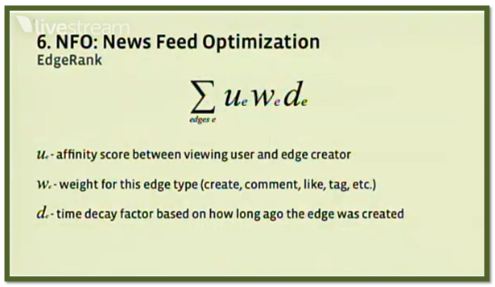 How Do I Get More Facebook fans to Engage With Me?
How Do I Get More Facebook fans to Engage With Me? 
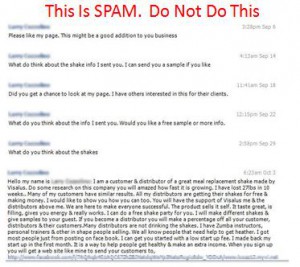 6. Comment and share–– If you want people to comment on your page then make it a habit to interact, comment, and share other people’s posts. It’s the law of reciprocity; the more you give, the more you will get in return. The new share button makes it very easy to share other people’s posts.
6. Comment and share–– If you want people to comment on your page then make it a habit to interact, comment, and share other people’s posts. It’s the law of reciprocity; the more you give, the more you will get in return. The new share button makes it very easy to share other people’s posts.